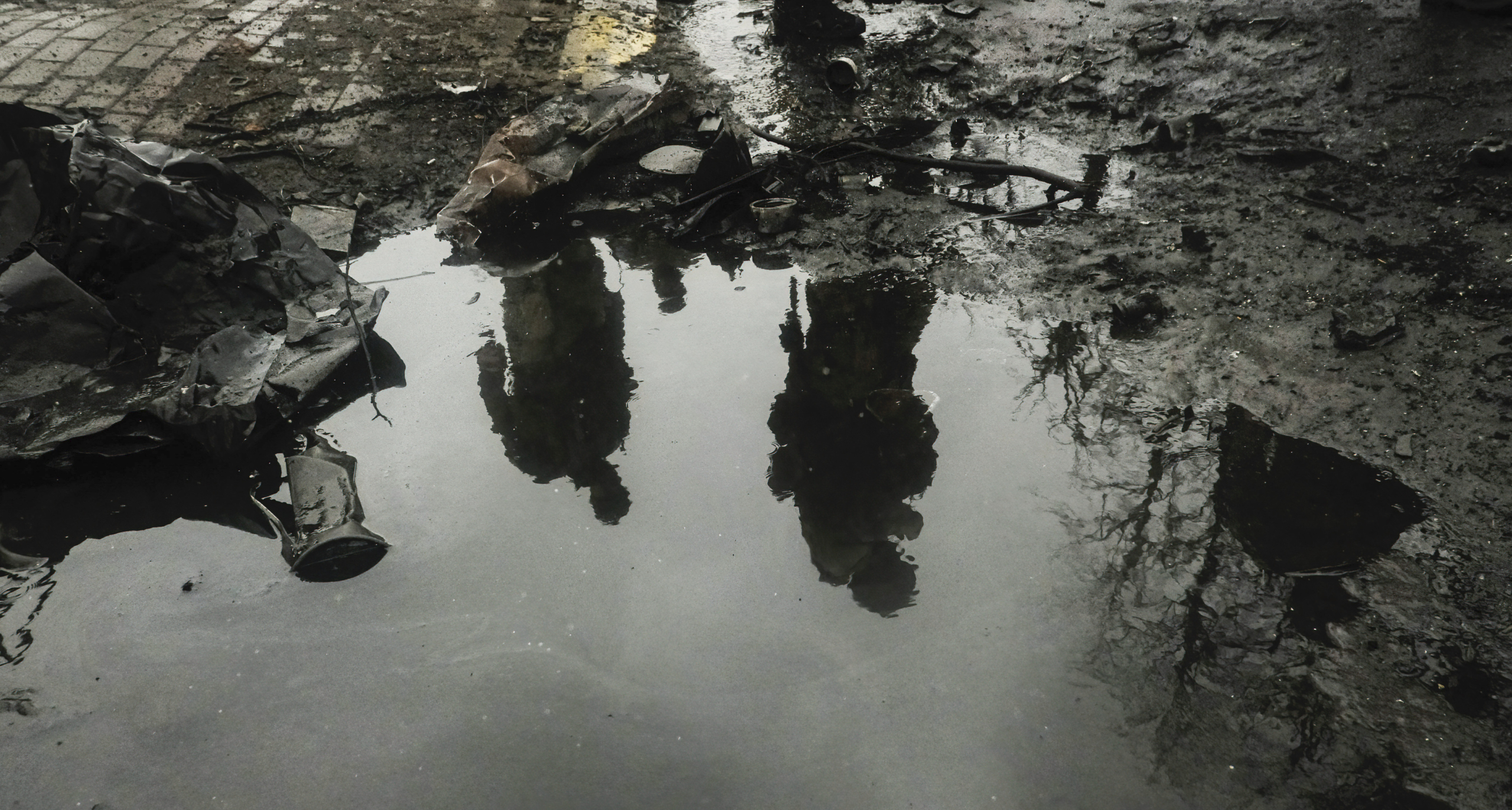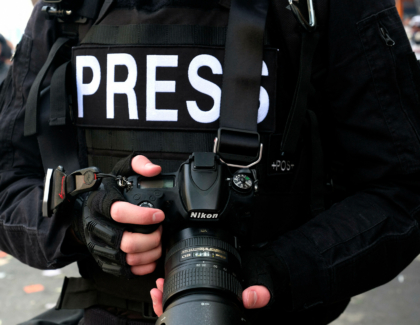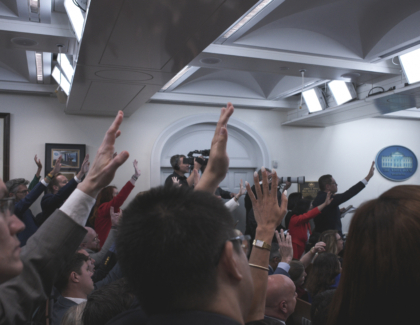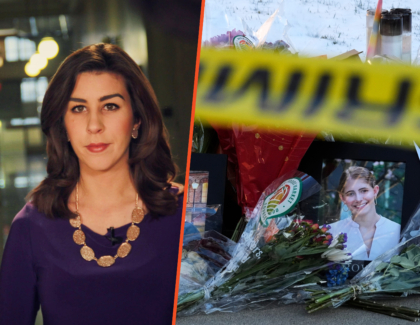Sign up for the daily CJR newsletter.
On March 11, Maks Levin, a Ukrainian photojournalist, posted a series of images to his Facebook page showing people evacuating Chervone, a village near Kyiv that had been occupied by Russian forces. Many of them had swaddled themselves in white clothes or sheets to show that they were civilians. Levin wrote that the scene was “like a horror movie.” The next day, March 12, Levin posted a photo, taken nearby, that showed smiling Ukrainian soldiers huddled by a fire next to the ruins of a bunker from World War II. Levin wrote that the present Ukrainian line of defense north of Kyiv traced the Soviet line from back then. “On other side of the river Irpin stood the troops of Nazi Germany,” he noted. “Now—russian army.”
The day after that, March 13, Levin went missing. He was last seen in a village close to Chervone to which he had traveled to cover fighting between Russian and Ukrainian troops. Oleksiy Chernyshov, a photographer turned serviceman (according to the Committee to Protect Journalists), was traveling with Levin, and went missing, too.
Related: Brent Renaud, Yevhenii Sakun, and the grave dangers on the ground in Ukraine
March 13 was a bleak day for press freedom in Ukraine: in a different area near Kyiv, Brent Renaud, a US filmmaker, was killed when Russian forces opened fire on a car he was traveling in; Juan Arredondo, another US journalist who was in the car, was wounded. Renaud was the first foreign media worker to be killed on the job since Russia invaded Ukraine, and the second media worker overall; Yevhenii Sakun, a camera operator for a Ukrainian broadcaster, was killed early in the war when Russia shelled a TV tower in Kyiv. (At least two Ukrainian journalists died while serving in the country’s defense forces.) In the three weeks since Renaud was killed, the death toll among working journalists has climbed. On March 14, Pierre Zakrzewski, a Franco-Irish cameraman for Fox News, and Oleksandra Kuvshynova, his Ukrainian colleague, were killed when their vehicle was hit, also in the Kyiv area; Benjamin Hall, a Fox correspondent, was injured in the same attack, but survived. The following week, Oksana Baulina, a Russian journalist with the independent Russian news site The Insider, was killed in a Russian shelling attack in Kyiv itself. She had been filming damage caused by a shelling attack.
Many other reporters on the ground have had narrow escapes or otherwise been threatened in the course of their work. Several Ukrainian journalists have, like Levin, disappeared. On March 11, Viktoria Roshchina, a reporter for the independent TV station Hromadske, went missing while en route to the besieged southeastern city of Mariupol. On March 12, Oleh Baturin, a journalist living near the Russian-occupied city of Kherson, left home for a meeting with an acquaintance and didn’t come back. On March 26, Iryna Dubchenko, a journalist in the southeastern city of Rozivka, disappeared after Russian soldiers searched her home. On March 30, Konstantin Ryzhenko, the editor of a local news site in Kherson, disappeared; Russian soldiers raided his family’s apartment and detained his brother. Baturin and Roshchina, it would transpire, had been detained by Russian occupiers. They were released after eight and ten days of detention, respectively. Dubchenko is thought to be in Russian detention in Donetsk. The whereabouts of Ryzhenko are unclear. His last, prescheduled post on the messaging app Telegram says: “if you are reading this text, it means that something has happened.”
Levin is no longer missing. On Friday, his body was found in the Vyshhorod area near Kyiv, not far from where he was last seen alive. His death was announced on Saturday by LB.ua, a news site where Levin worked. He also collaborated with international outlets including Reuters, the BBC, and, recently, Der Spiegel; he was forty, and had four children. According to the office of Ukraine’s prosecutor general, Russian soldiers shot Levin with “small arms fire.” Chernyshov, the man with whom Levin had been traveling, is reportedly still missing.
In recent days, Russian forces have withdrawn troops from the Kyiv region. Levin’s was not the only body they left behind—far from it. Yesterday, the prosecutor general said that the bodies of more than four hundred civilians have so far been found in the area. Journalists have not been able to confirm the toll, but have followed Ukrainian forces into liberated villages and towns—Bucha, most prominently—and fed back reports and photos of mass graves and corpses strewn across the ground. Some had their hands tied behind their backs. The sickening photos sparked renewed international condemnation of Russia. A senior European Union official cited the “haunting images” as he pledged further sanctions. Volodymyr Zelensky, the president of Ukraine, said on CBS yesterday that Russia has committed “genocide.” Russia denied harming a single civilian and said the images were faked.
Lie as it might, Russia, with its pullback, has begun to shine a ghastly, clarifying light on its devastation of the Kyiv area, the scale of which could only previously be glimpsed through a suffocating fog of war. Journalists on the ground worked bravely to pierce that fog where they were able. Levin, Renaud, and the others paid with their lives. In the aftermath of Renaud’s killing three weeks ago, I noted that press groups were still figuring out whether the journalists attacked in Ukraine to that point had been targeted because they were journalists, or whether, as one observer put it to CJR, they had gotten caught up in the broader context of Russia’s “absolute disregard for civilian life.” The killings and kidnappings since then seem to show that, across different cases, both things can be true. They also remind us that both can be true in an individual case: journalists, after all, are civilians. Every murdered reporter deserves for the circumstances of their death to be established; Levin’s killing is already being investigated. The same is true of everybody in the mass grave in Bucha.
It’s not yet totally clear what Russia’s withdrawal from the Kyiv region means for its faltering war in Ukraine, but it would seem to presage a renewed offensive on the south and east of the country. The danger is far from over. On Saturday, Mantas Kvedaravicius, a Lithuanian filmmaker, became, by my count, the first working journalist to be killed outside of the Kyiv area since the war began, reportedly in an attack by Russian forces as he tried to leave Mariupol. Kvedaravicius had long chronicled the city, which saw fighting between Ukrainian forces and Russia-backed militants in 2014, including in a documentary, Mariupolis. His aim, he once said, was to show “how regular people carry on with their everyday lives mere steps away from a war zone, gunshots, explosions, and death.” Mariupolis “is not about war, but about life next to war and lived in spite of war.”
Levin had also covered the war in eastern Ukraine dating back to 2014, not just in recent weeks. Announcing his death, LB.ua quoted him as once having said that “every Ukrainian photographer dreams of taking a photo that will stop the war.” In a past interview with LensCulture, he struck a different tone, saying that it would be “naive” to think that his photos might change the world, and that he was driven to keep covering conflict out of a sense of duty and a commitment to honesty. He was right both times, of course. Photos don’t tend to stop wars, not even when they’re as horrible as those out of Bucha. But they can achieve more than simply forcing the world to bear witness. The dream, at any rate, is worth clinging to.
Below, more on the war in Ukraine:
- Torture: Over the weekend, Baturin, the Ukrainian journalist who was kidnapped by Russian forces in the Kherson region but later released, spoke with The Observer about his experience. The meeting for which Baturin left home turned out to be a trap, he said, with Russian soldiers having abducted his acquaintance and forced him to lure Baturin to a meeting. Baturin was subsequently “held captive with little water, food, or medicine,” The Observer reports. “He was interrogated, tortured, threatened with mutilation and death, and told that his family would suffer. He had four ribs broken, he said.”
- The Russian journalists in Ukraine: The Guardian’s Shaun Walker spoke with independent Russian journalists who—like Baulina, prior to her death—have worked to cover the war from the ground and “break the Kremlin’s stranglehold on information.” Elena Kostyuchenko, a reporter for the newspaper Novaya Gazeta (which recently ceased publishing for the duration of the war), said that “every day, I see the crimes my country is committing. Every day I see injured people, dead people, destroyed houses, I spoke in Kherson with people who lived through kidnappings. It’s morally difficult, but I think it would have been morally more difficult to sit in Moscow and follow it on internet.”
- The Belarusian journalists in Ukraine: Reporters Without Borders (RSF) spoke with four journalists who fled Belarus—whose authoritarian, Russian-allied president, Alexander Lukashenko, has recently annihilated press freedom—for Ukraine. The journalists said that despite the war, they still feel safer in Ukraine than in Belarus, though all of them have become “the collateral victims of the sanctions that the Ukrainian authorities have imposed on Belarus,” RSF reports. All four journalists confirmed that “the Ukrainian central bank has blocked all bank accounts and bank cards held by Belarusian citizens.”
- Propaganda? International news organizations have regularly used images captured by Maxar Technologies, a US satellite company and government defense contractor, to illustrate the situation on the ground in Ukraine, and did so again over the weekend, with Maxar imagery appearing to show that the digging of the mass grave in Bucha began in the early phases of Russian forces’ occupation of the town. Writing for The New Republic last week, Jordan G. Teicher assessed whether Maxar’s images constitute “war propaganda.” They “have indeed proven an effective tool,” Teicher wrote. “But Maxar is by no means a neutral player when it comes to global conflict, and thus there are limits to what these images alone can tell us.”
Other notable stories:
- The Human Rights Campaign, a leading LGBTQ+ advocacy group, downranked Fox Corporation on its Corporate Equality Index in response to Fox News’s recent coverage, not least of a new Florida law banning schools from teaching young children about sexual orientation and gender identity. “We can no longer allow Fox Corporation to maintain its score if Fox News personalities and contributors continue to deny the existence of transgender people, minimize the violence transgender individuals face, refer to parents of LGBTQ+ youth as perverts, or equate leaders of LGBTQ+ diversity and inclusion efforts with sex offenders,” HRC said. (In response, Fox pointed to benefits enjoyed by LGBTQ+ staffers and its recent hiring of Caitlyn Jenner as a contributor.)
- Jen Psaki, the White House press secretary, will reportedly step down in the next few weeks and join MSNBC, where she’ll appear on cable and host a show on the Peacock streaming service. (She will not, as had been rumored, succeed Rachel Maddow in the 9pm hour.) On Friday, reporters pressed Psaki as to whether her talks with MSNBC pose a conflict of interest with her current job; Psaki wouldn’t be drawn on her plans, but stressed that she has generally upheld high ethical standards. She has reportedly recused herself from White House dealings with MSNBC and NBC. John Kirby, Karine Jean-Pierre, and Kate Bedingfield are all in the frame to replace her as press secretary.
- The Post’s Paul Farhi reports on disquiet at the Salt Lake Tribune after Paul Huntsman, the paper’s chairman, founded a separate company to investigate how the state of Utah has awarded coronavirus testing contracts. Huntsman said that he founded the company—named Jittai, after a Japanese word that can mean “actual condition”—to expose mismanagement and corruption, but several Tribune journalists fear that it is “an outgrowth of a purported rivalry” between the Huntsman family and Spencer Cox, Utah’s governor, who beat Huntsman’s brother Jon in the Republican primary in 2020.
- CJR’s Savannah Jacobson reports that WNYC and Gothamist took down forty-five stories after concluding that they contained “unattributed passages from other sources” or had been “published on other websites by the author”—a fresh development in a long-running attribution saga that Jacobson detailed in an in-depth recent CJR story about WNYC. Audrey Cooper, the station’s editor in chief, told staff that the forty-five stories were written by the same person and had been flagged by an outside auditor.
- Also for CJR, Caleb Pershan reported on a walkout at the Miami Herald and its sister titles, where unionized staffers refused to work on Friday in protest of stalled contract negotiations with McClatchy, the papers’ owner. The action was not literally a “walkout,” Pershan notes, since “there’s nowhere to walk out of,” with the Herald having given up its newsroom lease two years ago. (ICYMI, I wrote about media unions last week.)
- The Washington City Paper will end its regular print edition and publish primarily online after concluding that its “current way of operating was no longer sustainable.” (It will continue to print special editions on an occasional basis.) The paper is also losing five staffers including Darrow Montgomery, a photographer who has worked there since 1986.
- Les Zaitz, a powerhouse Oregon journalist, is looking to sell the Malheur Enterprise, a local paper. He now has an offer from Greg Smith, a state lawmaker whom the Enterprise has investigated. Nieman Lab’s Shraddha Chakradhar has more on the unusual bid.
- For Smithsonian, Nick Yetto profiled the Saguache Crescent, a tiny Colorado weekly that is “the last linotype-produced newspaper in the United States—and perhaps the world.”
- And in the UK, a climate activist glued his hand to a studio mic during a radio interview.
ICYMI: WNYC removes dozens of articles over attribution issues
Has America ever needed a media defender more than now? Help us by joining CJR today.







